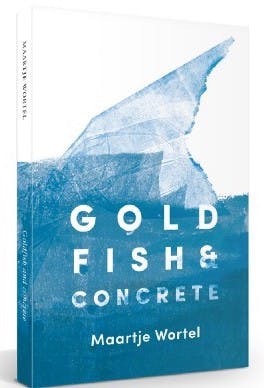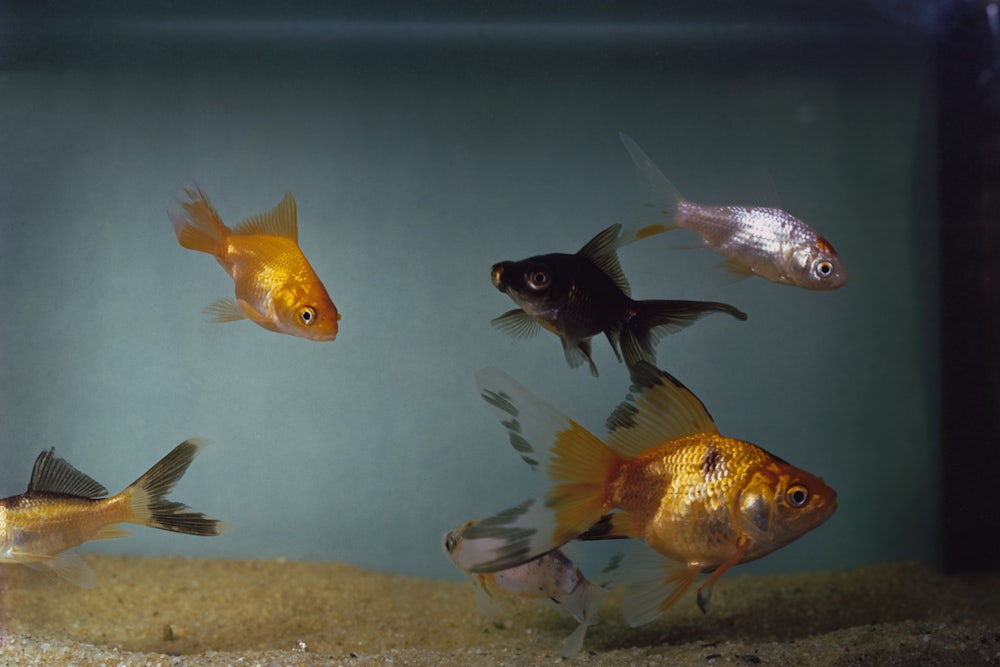Someone recently told me a Dutch saying that goes, Alleen is maar alleen. “Alone is just alone.” The wording is as dull as its meaning: nothing romantic about being alone, it says with resigned repetition. The same careless shrug as in, “That’s that.”
Maartje Wortel’s exquisite new novella, Goldfish and Concrete, explores loneliness in all its complicated, quiet, sometimes absurd and sometimes peopled space—as if to ferment the saying’s second “alone.” There’s poetry in emptiness, Wortel’s narrator discovers as she feels the shape of displacement left by loss. “For a long time,” the narrator tells us in the first pages, “I thought a holist was a person who believed in emptiness, in hollowing things out, a hole, a cavity, the space between buildings, fingers, between yourself and others. I pictured a duvet that a warm body had just emerged from underneath. It wasn’t about the body but the duvet, open and abandoned, leaving the warmth and shape of a person behind. It turned out this was my own belief.”

Wortel is an award-winning Dutch writer who, at 34, has already written two novels and two short story collections. With Goldfish & Concrete, she compacts a story of birth, death, family, fate, and heartbreak into a slim fifty-nine pages. To summarize: An unnamed narrator grieving her mother’s death and dealing with the loss of a lover (“you”) reflects on her father’s charismatic and inimitable worldview, combing over decades of his anecdotes whose lessons reflect back on her own current sense of loss. Scattered throughout are musings on the mating rituals of bees, craquelure (the hairline fractures in a glaze), the existential nature of computer games, and tree roots—all of which are seeds of imagery to later reap in metaphor. Driving us through is the narrator’s voice: cynical, addictively funny, and at times endearingly sincere. She’s the type of person you’d be happy to sit with for an afternoon at a café, commenting on the people going by.
The writing is tightly spun and surprising. Sentences are filled with tonally polar images: “When I was old enough, my mother not yet dead and the tunnel under the station not yet built, I moved from one side of the tracks (a train passing sounds like a kettle just before it boils) to the other, the rails forming a fault line between the past and present.” A mother’s death and tunnel construction lean into each other, one clobbering the seriousness out of the other’s ordinariness, and vice versa. In another passage, her father, sitting on the grass in a city park, thinks, “Here relationships were broken off or began, ducks were fed.”
Wortel rightly gives the narrator’s father—vivacious, tearful, lying, philandering, and verbose—the most page space for his stories and counseling, which she treats with equal parts admiration and skepticism. Of why he left his first wife and married the narrator’s mother: “He’d rather fall down with the right one than stand up straight with the wrong one. And of course my mother felt welcome, just like all the others did.” Of his temperament: “Sometimes he says he can’t take the smell of spring … or the way certain women step onto their bicycles, a little awkwardly. Then he’ll say: ‘I’m a mollusk. I almost can’t take this.’” Inspired to develop a fire escape plan from their house after drinking too much whiskey, he hangs a rope out the second story window, grabs hold, jumps, and slides down into the garden while gripping the rope “overly anxiously,” burning his hands. “I couldn’t think of a more fitting image to sum up his personality,” the narrator reflects. “My father was able to burn his hands without a fire.”
Other characters appear to offer their own worldviews. A Buddhist guy the narrator meets in the woods—they watch red turtles that “must have been released in the woods because someone had exchanged their ardent desire for a few turtles for a desire for independence”—tells her that “An unhappy person, just like a happy person, is an egoist.” In this section comes one of the smartest lines of the book: “Now [the turtles] were swimming in the pond in the woods, far from where they belonged, and also far from where they didn’t belong.” Just try to find a moment or phrase throughout that doesn’t loop into double, triple meanings.
At times, the novella feels like a choir of philosophers—father, mother, Buddhist, lover—all singing a different song in the same room. The book’s melody is in how the narrator examines or contradicts each character’s advice or stories—something like turning out the pocket of every thought, shaking it out, showing another shape to it. One of the best moments comes from the narrator herself, after her father advises her to take up painting to combat sadness. Instead of rejecting the naïve suggestion, she says, “Now I know. No resistance. It is like when a wild animal grabs you, or a strong current: feign ignorance. Don’t be a hero.”
The book’s axis, though, is heartbreak. In those sections come the most direct musing on loneliness, on the character of that emptiness: “Your silence is all-encompassing … it’s a pain that makes my heart hum at night. I used to think that a heart could only beat, but a heart can do so much more. … My heart buzzes like an insect, as though it wants to drown itself out in vibrations. Or worse, like a device with a battery that’s going flat. Insects are useful creatures, and that’s the way I like to see my heart too. … How clever that those creatures can bear their own weight. I don’t know if people are capable of that. I’m not, at any rate.”
The passage which the book takes its title from comes near the end, and is delivered in the patent twisted chronology: “At times I thought I’d found someone, we spoke the same language for a while, but in the end there was nothing left but goldfish and concrete, which sounds really nice but you should see how something like that turns out in the end.” Later: “I put a goldfish on the concrete next to the railway track. A small, orange, living fish on the hard grey ground … It lay there on the concrete and accepted its fate. I looked at it and I thought of you. I have seen life and I have seen death. I thought of water around the fish. I thought: water! But the fish was already too far gone.”
The book contains full-page, abstract, cerulean illustrations by Janine Hendricks scattered throughout. It’s divided into 29 sections: Section 22 is written with a backwards 2, to make a heart with other 2; “I love hands shuffling cards” is a stand alone on a page. Otherwise, the surprises are all linguistic. It is a book about the texture of a vacuum. Written in the fractured form of its own subject, it asks the reader to fill in the space between the imagery and metaphor. From that, comes the story.
